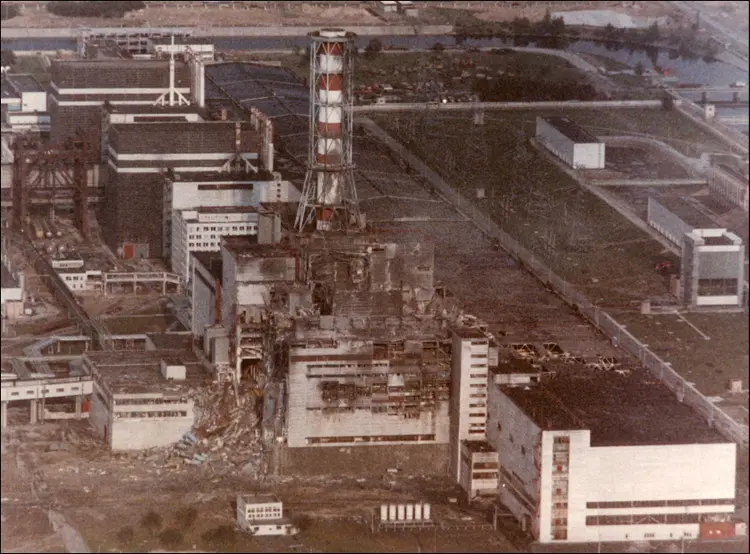
Introduction
On April 26, 1986, what began as a routine safety test at the Chernobyl nuclear power station in Ukraine spiraled into history’s worst nuclear disaster. This catastrophic meltdown not only claimed lives but also cast a long and ominous shadow over the region, rendering it uninhabitable to this day. This article provides a detailed chronological account of the events leading to the Chernobyl disaster, the immediate aftermath, and the long-term consequences that continue to reverberate.
Prelude to Disaster
September 26, 1977: The Chernobyl nuclear power station commences its power supply to the grid, positioned approximately 65 miles north of Kiev, Ukraine.
February 1986: A Soviet official downplays the risk of a nuclear meltdown, asserting odds of “one in 10,000 years.” By this time, the site houses four operational 1,000-megawatt reactors, with two additional reactors under construction.
Unraveling the Catastrophe
Safety Test Sets the Stage
April 25, 1986, 1 a.m.: Operators initiate a safety test on reactor No. 4, aiming to assess the plant’s ability to maintain coolant pumps during a power failure. Ironically, this safety test becomes the catalyst for the reactor’s destruction.
April 26, 1986, 1:23:04 a.m.: The test begins, triggering an unexpected power surge.
April 26, 1986, 1:23:40 a.m.: An operator attempts an emergency shutdown, but control rods jam as they enter the core.
April 26, 1986, 1:23:58 a.m.: The first explosion rocks the reactor, blowing the roof off and unleashing a fireball. Chaos ensues as radiation is released, fires erupt, and the plant succumbs to devastation.
Immediate Aftermath
April 26, 1986, 1:28 a.m.: Firefighters arrive at the scene unaware of the radiation risks and lacking protective gear.
April 26, 1986, 2:15 a.m.: Emergency measures are implemented, including a roadblock around Pripyat, a nearby city built for Chernobyl’s workers.
April 26, 1986, 5 a.m.: Reactor No. 3 is shut down, followed by the closure of reactor Nos. 1 and 2 the next morning.
April 26, 1986, 6:35 a.m.: Fires are extinguished, except for the blaze in the reactor core, which continues for days.
April 27, 1986, 10 a.m.: Helicopters dump materials into the burning core to mitigate radioactive emissions.
Delayed Evacuations
April 27, 1986, 2 p.m.: Soviet officials initiate evacuations, withholding information for 36 hours. Approximately 115,000 people from Pripyat and nearby areas are evacuated, believing it to be temporary.
April 28, 1986: Swedish air monitors detect radiation traced back to the USSR. Soviet officials admit to an accident but falsely claim control.
April 29, 1986: U.S. officials glimpse the disaster’s extent through spy satellite photos.
May 1, 1986: Soviet officials proceed with May Day festivities in Kiev, despite ongoing radiation release.
Cleanup Efforts and Sarcophagus Construction
May 4, 1986: Liquid nitrogen is pumped beneath the reactor. Cleanup efforts involve 800,000 workers, including bulldozing contaminated areas and burying radioactive topsoil.
May 9, 1986: Concrete is poured beneath the reactor, eventually encased in a colossal concrete and metal structure named the sarcophagus.
May 14, 1986: Soviet leader Mikhail Gorbachev addresses the public about the incident, stating “the worst is behind us.”
August 25-29, 1986: International Atomic Energy Agency conference attributes the disaster to human error, safety culture, and Soviet reactor design flaws.
December 15, 2000: Unit 3, the last operating reactor at Chernobyl, is shut down.
Legacy and Long-term Consequences
April 2006: Gorbachev suggests the Chernobyl disaster, more than perestroika, led to the collapse of the Soviet Union.
The Chernobyl disaster stands as a stark reminder of the catastrophic consequences of nuclear power gone awry. The immediate loss of lives and the enduring environmental and health impacts underscore the need for stringent safety measures and responsible nuclear practices as humanity navigates the complexities of harnessing nuclear energy.





